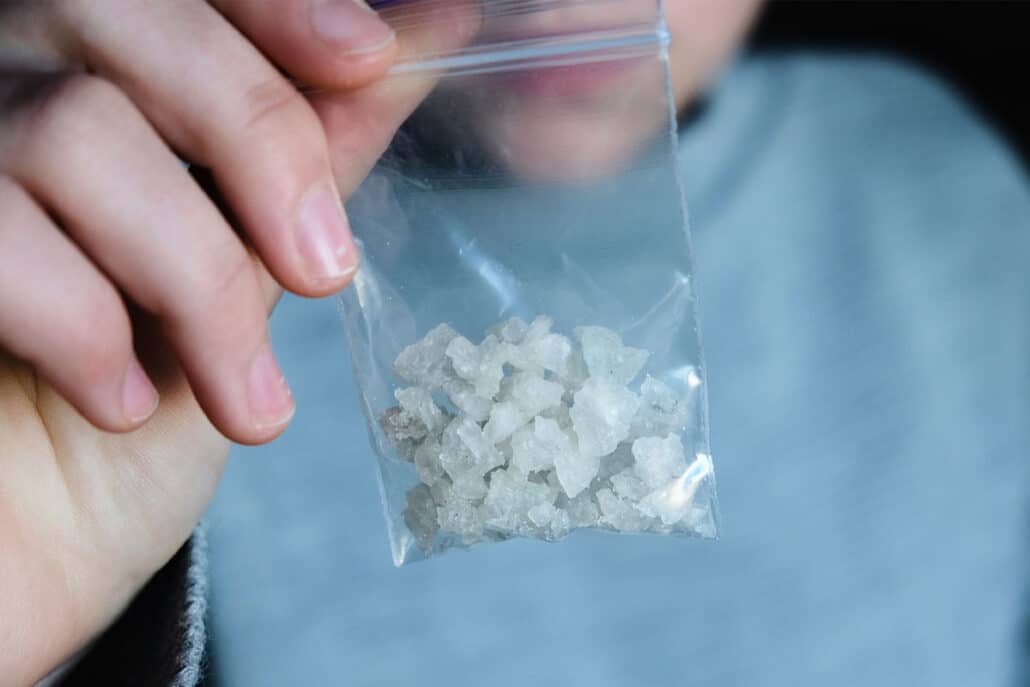Many people believe that speed and meth are the same drugs. However, there are some clear differences between the two. Both types of drugs are stimulants, which can be used to treat ADHD (attention deficit hyperactivity disorder), narcolepsy, and other disorders. Methamphetamine is an illicit type of amphetamine. To more effectively compare speed and meth, you should first understand how amphetamines and methamphetamines differ.

Table of Contents
What Are Amphetamines?
Amphetamines are stimulants that include prescription drugs and illegal substances. The main form of amphetamine that’s illegal is methamphetamine. While standard amphetamines are meant to be prescribed to people who suffer from ADHD or similar disorders, they are often taken by college students to boost their alertness when studying. It’s also common for students to take these drugs because of their ability to suppress appetite and sleep.
If you receive a prescription for amphetamines, it will come in the form of a pill. When people misuse an amphetamine, they might inject, smoke, or snort it, which ensures it has a more potent effect. While prescription amphetamines can be abused, these drugs are different from meth.
What Is Methamphetamine?
Methamphetamine is a stimulant drug that’s classified as an amphetamine. It’s a drug that can’t be obtained via a prescription because of its extremely high potential for substance abuse. Between 1930-1971, meth could be obtained with a prescription. It was used to treat everything from ADHD and obesity to asthma.
Once the U.S. banned the drug from being available through prescription in 1971, it became a highly popular street drug. When taken, meth produces a strong stimulation within your central nervous system. The side effects people often experience when using meth include the following:
- Lower appetite leading to weight loss
- Hallucinations
- Increased excitement and alertness
- More energy
- Elevated blood pressure and body temperature
- Euphoria
- Increased breathing rate and heart rate
Methamphetamine works by increasing concentrations of serotonin, dopamine, epinephrine, and other neurotransmitters in the brain. Each chemical can have a potent effect. Dopamine is directly involved with helping people feel more motivated and satisfied. When the brain contains a higher level of dopamine, these feelings increase.
Epinephrine and norepinephrine are responsible for a person’s fight-or-flight response. When there’s a higher concentration of these chemicals in the brain, you might feel more alert. However, maintaining elevated levels of these chemicals for an extended period can cause more stress.
As for serotonin, it impacts a person’s mood. When your serotonin levels are high, you’ll feel good. It’s believed that people who suffer from depression have lower serotonin levels.
Methamphetamine Types
There are two specific forms of methamphetamine, which include l-methamphetamine and d-methamphetamine. While both drugs are comprised of the same chemicals, the arrangement differs. Keep in mind that L-meth existed first, which is why it’s considerably less potent than D-meth. It’s estimated that D-meth is two times as strong as L-meth. The production method is also much simpler.

The majority of methamphetamines are available in the form of crystal meth. When the drug is in powdered form, people will resort to dissolving or snorting it. When meth is in powdered form, it’s often referred to as speed. While crystal meth has a potency of 80%, the potency of the speed version of meth is just 20%. Keep in mind, however, that the more traditional type of speed isn’t meth.
How Amphetamine and Methamphetamine Differ
While methamphetamine is a type of amphetamine, not every amphetamine is meth. These drugs are much different regarding, potency, overdose risk, and duration.
Addictive Properties
Because meth is a stronger version of amphetamine, it’s more likely to be abused by people who take even a small dose. A single use of this drug can make your body dependent on it. In comparison, the addictive properties of prescription amphetamines aren’t as strong. If you follow the dosage instructions on your prescription amphetamine, it’s unlikely that you’ll become dependent on it.
While prescription amphetamines aren’t as addictive, you can become dependent on them if you take the drugs without a prescription. People who receive a prescription may become addicted if they take a higher dose than prescribed.
Potency
The primary difference between meth and standard amphetamines involves potency. Meth is much stronger. If you take the same dose of these two drugs, the effects would be four times stronger with meth. Even though both drugs increase neurotransmitter levels, meth boosts dopamine levels around five times more than Adderall or a similar amphetamine.

Potential for Overdose
Since methamphetamine has a higher potency than amphetamine, the risk of an overdose is higher as well. Keep in mind that overdosing on the drug is more likely after you’ve detoxed from it. Let’s say that your body became dependent on meth, which pushed you to receive treatment. During treatment, people go through detox to ensure the drug is out of their system before they proceed to therapy. If you try to take the same amount of meth after detox, the results could be fatal.
The risk of an overdose is also higher because of how it’s manufactured. Meth is made by criminals and is often cut with other harmful drugs. By mixing other compounds with meth, drug dealers are able to increase the potency and reduce their costs. In comparison, prescription amphetamines are produced by pharmaceutical companies.
Duration of Effects
Because of how strong meth is, it usually lasts longer than the majority of prescription amphetamines. If you take a prescribed dose of amphetamines, the effects will likely only last for around four to six hours. While some extended-release amphetamines can last for up to 10 hours, meth usually lasts for longer.
The amount of time meth produces effects depends on how the person takes it. When someone snorts or ingests a normal amount of meth, the effects may last for around six to eight hours. However, taking a high dose of the drug might cause it to remain in your body for around 24 hours. The same is true if you smoke or inject meth into your body.
| Category | Amphetamine | Methamphetamine |
| Classification | A stimulant drug; includes medications like Adderall | A more potent type of amphetamine |
| Addictive Properties | – Lower risk when used as prescribed – Risk increases with misuse | Highly addictive—even one dose can lead to dependency |
| Potency | Standard potency | ~4x stronger effects than amphetamine Boosts dopamine ~5x more than Adderall |
| Overdose Risk | Lower risk; regulated pharmaceutical production | High risk—especially after detox or due to being cut with other substances |
| Duration of Effects | – 4–6 hours for standard dose – Up to 10 hours for extended-release | – 6–8 hours for normal dose (snorted/ingested) – Up to 24 hours for high dose or injected/smoked |
| Manufacturing | Produced by pharmaceutical companies | Often illicitly made; may be mixed with harmful additives |
| “Speed” Comparison | “Speed” often refers to amphetamines (prescription or illicit powdered form) | Meth is sometimes referred to as “speed” but is generally stronger and more dangerous |
| Effects | Increased alertness and physical activity | Same effects but typically more intense and longer-lasting |
Is Speed the Same as Methamphetamine?
Meth isn’t speed. While some types of meth are called speed, this term is most often used as a representation of all types of amphetamines. Since speed can refer to prescription amphetamines, it’s considered less potent than meth.
As touched upon previously, the people that mention “speed” as a type of meth are referring to the powdered form of the drug. Meth is snorted, which is a route of administration that makes the drug weaker than crystal meth.
The term “speed” was first coined because of the stimulating effects that occur in a person’s body and brain. People who take prescription amphetamines or meth feel more alert and display a higher level of physical activity.

Identifying Withdrawal Symptoms
Whenever you stop taking any drug that you’ve been misusing, you’re likely to encounter withdrawal symptoms. The types of withdrawal symptoms that commonly occur with meth and various prescription amphetamines include:
- Fatigue or tiredness
- Body chills
- Memory issues
- Vivid nightmares or dreams
- Agitation or anxiety
- Jittery feelings
- Depression
- Increased appetite
- Dehydration
- Insomnia
- Lower heart rate
During the withdrawal phase, you’ll likely experience intense cravings for the drug. In this scenario, you’re at a higher risk of relapsing. People who go through withdrawal from speed or meth often have thoughts of suicide. However, the severity of the symptoms you encounter depends on how much and how long you’ve used the drug. Misusing uppers like meth for a lengthy amount of time can result in a more intense withdrawal process. This process usually lasts for anywhere from two to seven days.

Possible Treatment Options
Several different types of addiction treatments are administered to people who are addicted to speed or meth. The most effective treatment programs use a combination of detox and therapy. If you go through detox at a medical or inpatient facility, you’ll be able to get the drug out of your body in a safe and structured manner. Before the detox program begins, you’ll take part in a medical assessment to determine the severity of your withdrawal and how much of the substance is still in your system.
While some people attempt to quit cold turkey, this isn’t a good idea. Stopping usage of the drug immediately increases the likelihood that you’ll have severe withdrawal symptoms. These symptoms include everything from seizures and psychosis to cardiovascular arrest.
Once the drug is out of your body, you can progress to treatment. Substance use treatment helps patients learn how to manage their addiction and avoid relapsing. Treatment can be provided on an inpatient or outpatient basis.
Speed and meth are two drugs that have a lot in common. However, while speed can be prescribed in the form of Adderall or a similar medication, meth is too potent to be used safely or legally. If you’re suffering from a substance use disorder, call Long Island Interventions today to take the first step on the road to a long-term recovery.
Published on: 2024-01-17
Updated on: 2025-04-26

